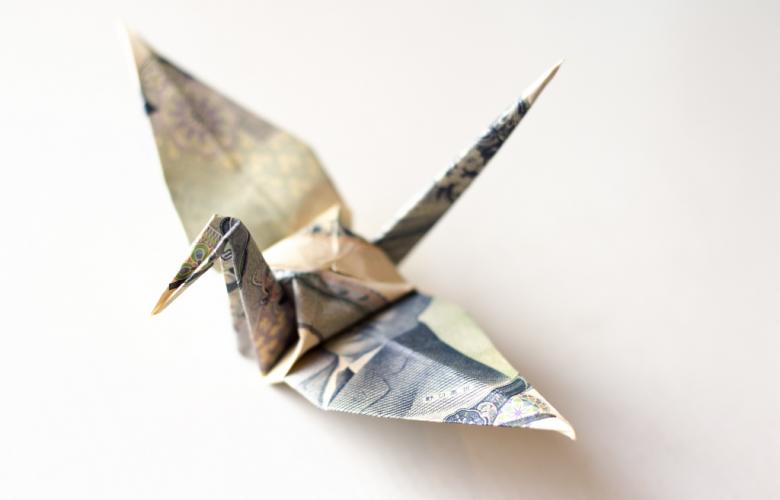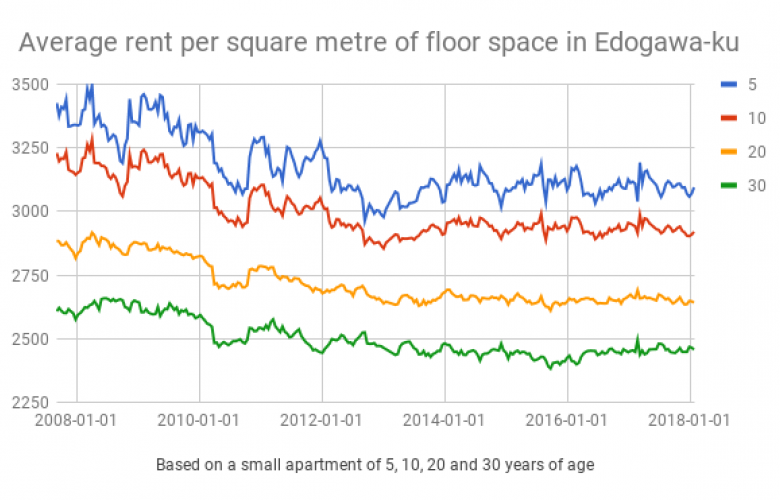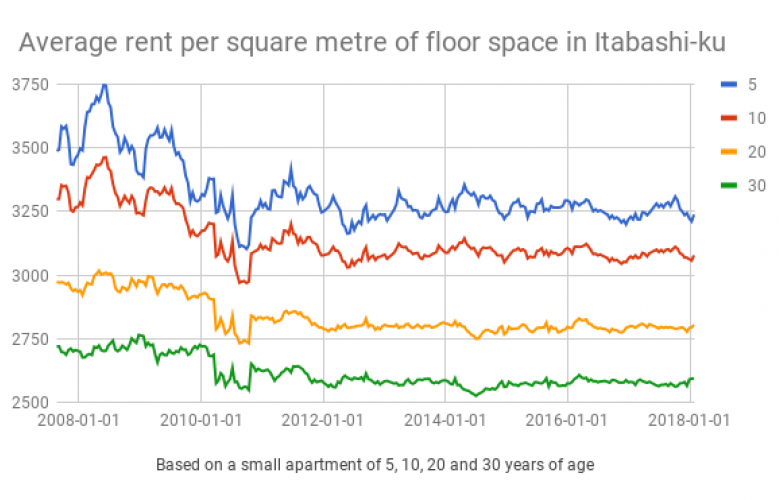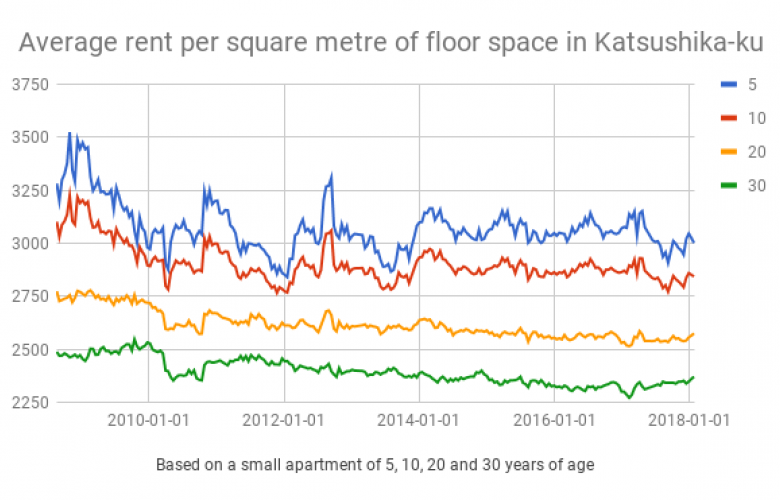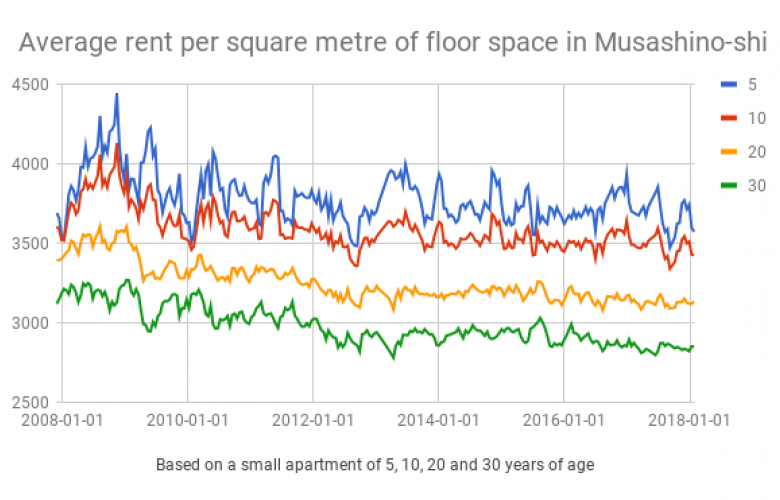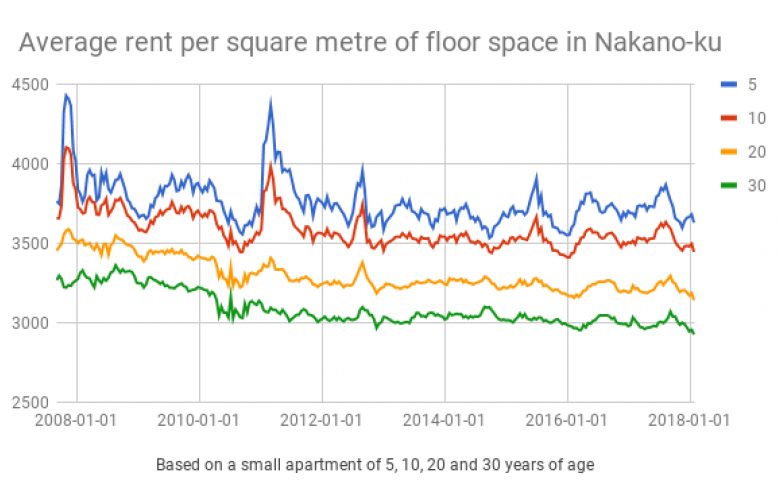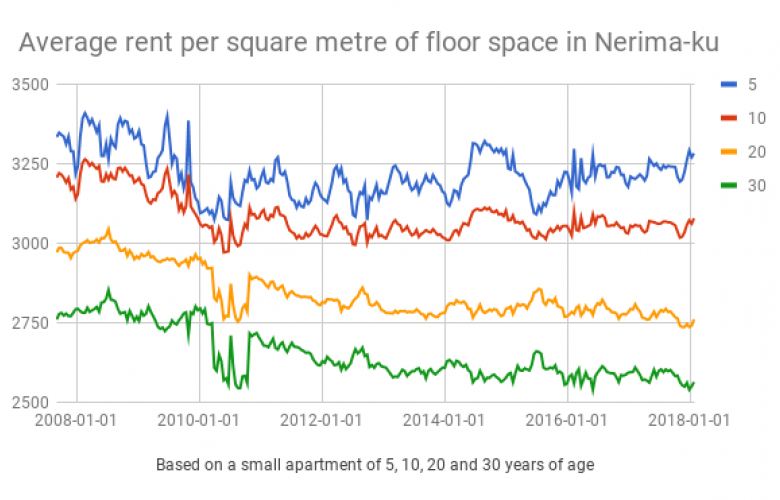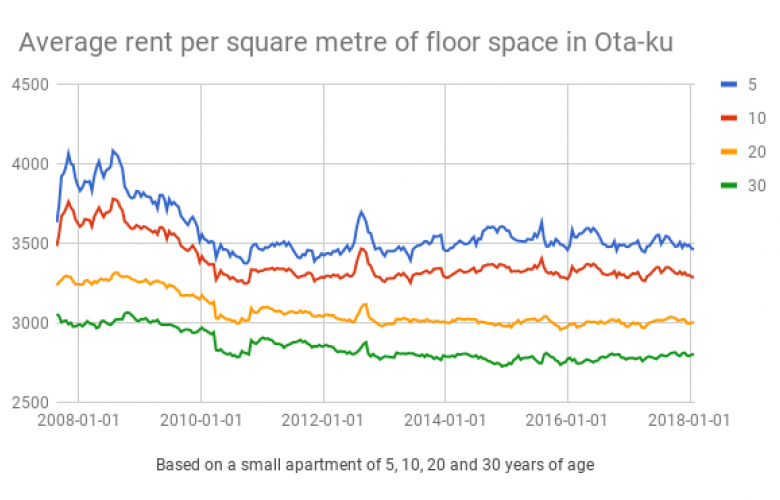Tokyo may not be the priciest part of the world in which to build a life, but it certainly isn't the cheapest, either.
For people planning to move to or within the prefecture, it pays to know the areas that are most affordable — and that's exactly what this article is about.
We've already covered neighbourhoods where rent is on the rise. This time, we showcase some of the wards where rent seems to have been decreasing over the past year or so.
Note: The findings presented here are based on the average rent (when signing a lease), in Japanese yen, of a simple one-bedroom apartment (25 sq m) in the main wards of Tokyo over the past 12 months. Data source: Akasaka Real Estate.
Three big dippers

Katsushika
Rents for newer apartments in this northeastern part of Tokyo saw a small peak and then deep trough over the past 12 months, with prices slightly rebounding recently.
At the end of January last year, a flat no more than five years old would have set you back roughly 76,800 yen a month; as of January this year, the cost had dropped to 75,050 yen. Something slightly older (10 years or so) went for around 71,500 yen, a rental figure that had gone down to 71,100 yen the same time this year. Meanwhile, the same tenant signing a lease in September might have paid a monthly rent of closer to 72,700 yen or 69,300 yen respectively ù indicating that this area is definitely one worth watching.
Apartments of 20 and 30 years of age have not followed this trend, with average rents stable to slightly elevated. A 20-year-old flat cost approximately 62,950 yen a month at the end of January, 2018, while a 30-year-old flat went for nearer 57,150 yen. A year later, they were priced at 64,375 yen and 59,275 yen respectively.
While all of the above add up to some of the most reasonably priced accommodation in Tokyo, it is the newer categories of apartment that seem to offer real bargains.

Musashino
Over in the west, Musashino has experienced similar patterns in rent prices.
At the end of January, 2018, a brand-new (five years old) pad cost around 92,500 yen a month, while a slightly older abode (10 years) went for 87,250 yen. Those in the 20-year category were about 78,275 yen, those in the 30-year category, 71,325 yen.
At the end of January this year, the rents were 89,300 yen, 85,600 yen, 78,350 yen and 71,275 yen respectively.
It would seem that those wanting to rent a snazzy, fresh flat in this area might have some luck with prices, peaks aside.

Nakano
In this up-and-coming ward of Tokyo, rents have fallen significantly in recent months — especially for older buildings.
At the end of January last year, a five-year-old pad would have set you back roughly 92,200 yen a month. Average rents for 10-, 20- and 30-year-old options were around 87,900 yen, 80,850 yen and 75,850 yen respectively.
As of January this year, those rates had dropped to approximately 90,725 yen, 86,125 yen, 78,550 yen and 73,150 yen respectively.
This dip seems promising for those looking to get a foothold in this trendy neighbourhood.
Other neighbourhoods to watch

Edogawa
After a spike early last year, rents in Edogawa have come down in all age categories of apartment other than the oldest (strangely enough).
At the end of January last year, a five-year-old flat cost in the region of 77,925 yen per month, while those in the 10-, 20- and 30-year age groups went for around 73,675 yen, 66,575 yen and 61,350 yen respectively.
At the same time this year, prices stood near 77,375 yen, 73,000 yen, 66,050 yen and 61,425 yen for each of the above categories — keeping the area one of the more affordable in Tokyo.

Itabashi
While apartments that have seen two or three decades seem to be fairly stable rent-wise, the prices of newer buildings have dipped since late last year, following a period of elevation.
Prices at the end of January this year may not have been quite as low as they were 12 months prior, but the overall downward trend is one worth watching for those looking to move into a squarely suburban but well-connected part of Tokyo.
At the end of January last year, average monthly rents for 5-,10-, 20- and 30-year-old flats were 80,475 yen, 76,650 yen, 69,950 yen and 64,475 yen respectively.
The end of January this year saw those figures shift to 80,950 yen, 76,950 yen, 70,100 yen and 64,825 yen.
While this means that tenants who signed leases early last year probably paid slightly less than those who did so this year, the recent drop has offered some respite from the peak of October.

Nerima
Bordering Itabashi, Tokyo's Nerima Ward has seen a nice drop in the average rents of older apartments.
While prices for five-year-old flats are spiralling upwards, 20- and 30-year-old options are heading steadily down to earth.
At the end of January last year, these golden oldie categories of apartment would have cost a tenant roughly 69,800 yen and 64,875 yen a month respectively — both reasonable rentals.
Twelve months later, these figures had dropped to 69,025 yen and 64,100 yen.

Ota
Over in Ota, rental prices for the newer categories of apartment have slumped after a small peak late last year.
At the end of January, 2017, a brand-new (five years old) flat went for, on average, 87,475 yen a month. 10-year-old places were priced closer to 82,775 yen, while 20- and 30-year-old joints went for 75,025 yen and 69,475 yen respectively.
By the end of January this year, those figures had shifted to 86,550 yen, 82,225 yen, 75,100 yen (a negligible increase) and 70,075 yen.
A quick look at the graph seems to suggest that for those looking to rent a new flat, prices may be heading in a positive direction overall.
In some of the other parts of Tokyo, rents for certain age categories of buildings have dropped at the same time as others have shot up. Read our complementary post to see what we mean.
What to know about older buildings in Tokyo
Despite some vociferously expressed concerns to the contrary, older buildings are actually perfectly liveable and, as you can see, a good deal cheaper, too.
The one thing to watch out for is earthquake safety. Buildings that are 20 or 30, even 35 years old, are generally considered fine — it's those that were erected before 1981 that need careful consideration.
In the year 1981 was the point at which Japan revised its building standards to provide greater protection against big quakes. So if you're looking at living in a place that's been around since the 70s or earlier, you might want to bear that in mind.
Disclaimer: The prices listed here are intended to provide rough estimates only, and should in no way be relied on for property decisions of any kind.
By Carey Finn
Similar to this:
Is your Tokyo neighbourhood getting more expensive?
Out with the old, in with the new: Why older buildings are unpopular in Japan
Is Japan forecasting the future of housing?

